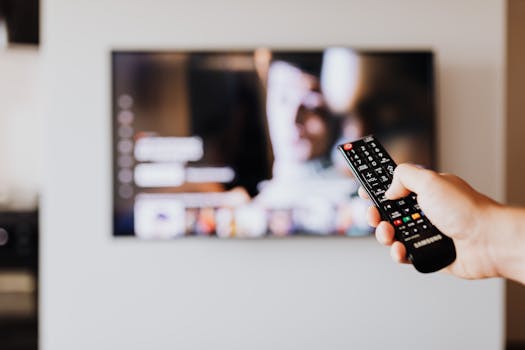
Buying a new smart TV is exciting, but don't let the dazzling display distract you from a crucial component: the remote control. The remote is your primary interface, and overlooking its features can lead to frustration and a less-than-ideal viewing experience. This guide will walk you through what to look for in a smart TV remote to ensure seamless control and maximum enjoyment.
Smart TV Remote Control: Don't Overlook This Critical Feature!
Buying a new smart TV is exciting, but don't let the dazzling display distract you from a crucial component: the remote control. The remote is your primary interface, and overlooking its features can lead to frustration and a less-than-ideal viewing experience. This guide will walk you through what to look for in a smart TV remote to ensure seamless control and maximum enjoyment.
The Unsung Hero: Why the Remote Matters
In the age of smart TVs, the remote control is more than just a channel changer. It's your key to unlocking a world of streaming services, apps, and advanced features. A well-designed remote can make navigating this digital landscape a breeze, while a poorly designed one can turn it into a frustrating chore. Think of it as the steering wheel of your entertainment system; you need it to be responsive, intuitive, and comfortable to use.
Beyond Basic Functionality
Gone are the days of simple up, down, left, right navigation. Modern smart TV remotes often include:
- Voice Control: Integrated voice assistants like Google Assistant or Alexa allow you to control your TV, search for content, and even manage smart home devices with just your voice.
- Dedicated App Buttons: Quick access to popular streaming services like Netflix, Amazon Prime Video, and Hulu with dedicated buttons.
- Air Mouse/Pointer: Allows for more precise cursor control, especially useful for navigating web browsers or complex menus.
- Backlit Buttons: Illuminated buttons for easy use in dark rooms.
- Number Pads: While less common, some remotes still include number pads for direct channel input.
Key Features to Consider
When evaluating a smart TV, pay close attention to the remote control. Here's what to look for:
1. Ergonomics and Comfort
- Shape and Size: Does the remote fit comfortably in your hand? Is it too bulky or too small?
- Button Placement: Are the buttons logically placed and easily reachable with one hand?
- Weight: Is the remote too heavy or too light? A well-balanced remote feels more substantial and easier to control.
Practical Tip: Visit a store and physically hold the remote. Imagine using it for extended periods. Does it feel comfortable?
2. Button Layout and Functionality
- Intuitive Design: Is the button layout easy to understand and navigate? Are the most frequently used buttons easily accessible?
- Dedicated Buttons: Are there dedicated buttons for essential functions like volume, channel, input selection, and power?
- Customizable Buttons: Some remotes allow you to customize certain buttons to launch your favorite apps or perform specific actions. This is a huge plus!
Example: Imagine you primarily use Netflix and YouTube. A remote with dedicated buttons for these services saves you several clicks every time you want to watch something.
3. Voice Control Capabilities
- Voice Assistant Integration: Does the remote support your preferred voice assistant (Google Assistant, Alexa, etc.)?
- Microphone Quality: Is the microphone clear and responsive? Does it accurately pick up your voice commands even from a distance?
- Voice Search Functionality: Can you use voice to search for specific content, browse channels, or control other smart home devices?
Tip: Test the voice control feature in a store if possible. See how well it understands your commands in a noisy environment.
4. Connectivity and Compatibility
- Bluetooth vs. Infrared (IR): Bluetooth remotes offer greater range and don't require a direct line of sight to the TV. IR remotes require a clear line of sight.
- Universal Remote Functionality: Can the remote control other devices, such as your cable box, Blu-ray player, or soundbar? This can simplify your setup and reduce clutter.
- Compatibility with Other Devices: Does the remote work seamlessly with other smart home devices you own?
Example: A Bluetooth remote allows you to hide your set-top box behind the TV without affecting remote control functionality.
5. Battery Life and Charging
- Battery Type: Does the remote use disposable batteries or a rechargeable battery?
- Battery Life: How long does the battery last on average? Rechargeable remotes typically offer longer battery life.
- Charging Method: If the remote is rechargeable, does it use a USB cable or a charging dock?
Tip: Consider the long-term cost of replacing batteries versus the convenience of a rechargeable remote.
The Remote's Role in Accessibility
For users with visual or motor impairments, the remote control's design is even more critical. Look for remotes with:
- Large, High-Contrast Buttons: Easier to see and press.
- Voice Control Functionality: Allows hands-free operation.
- Tactile Markings: Raised markings on buttons for easier identification.
- Customizable Button Mapping: Allows users to remap buttons to suit their individual needs.
Conclusion: Don't Settle for Less
The smart TV remote control is an integral part of your entertainment experience. By considering the factors outlined above, you can choose a remote that enhances your viewing pleasure and simplifies your digital life. Don't overlook this crucial component when buying your next smart TV. A little research can go a long way in ensuring you get the most out of your investment. Prioritize comfort, functionality, and compatibility to ensure a seamless and enjoyable viewing experience for years to come.
